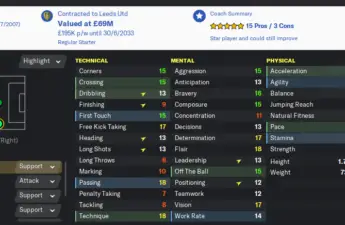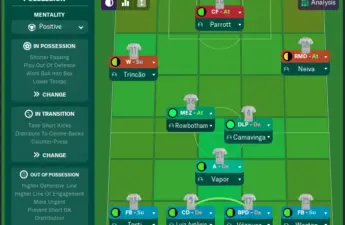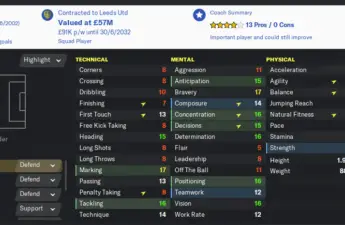The pressing forward in football manager draws many parallels to the advanced forward. However, this role is not simply an advanced forward who presses, as many FM players assume. There are a lot of nuances that come with the three duties the pressing forward role position comes with, i.e. defend, support and attack.
The differences between the three duties are mainly seen when the pressing forward is in possession of the ball.
In the defend duty, the pressing forward will simply lay off the ball to more creative players in the team like the enganche, trequartista, advanced playmaker, or shadow striker depending on your tactical setup.
This defend duty suits strikers who can press well but do not possess the vision and passing skills of a playmaker to create chances for their teammates. They, therefore, win the ball high up the pitch and choose the safest passing route possible.
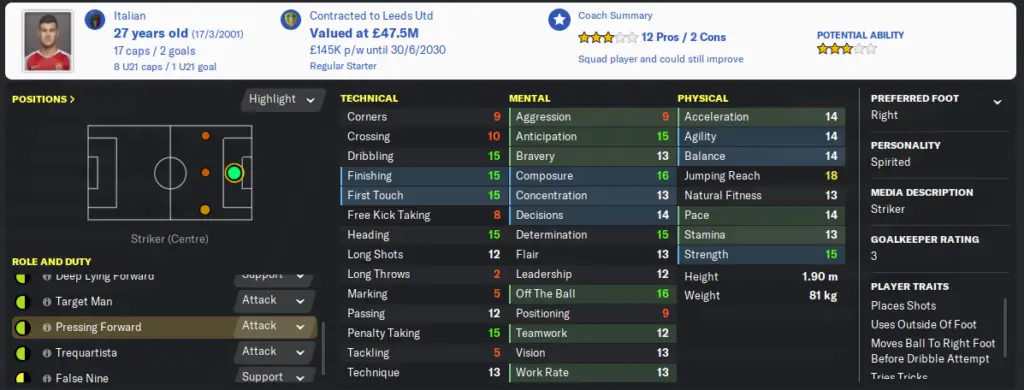
In a support duty, the pressing forward has some freedom to his passing range but is not yet capable of making defense splitting passes for his strike partner to run into. When provided the space, he will make a telling pass, but when under pressure or in tight spaces, he will more often than not pass the burden to the team’s playmaker.
The attack duty of the pressing forward is one that is most similar to the advanced forward. The pressing forward in the attack duty will look to spearhead the team’s attack when they are in possession of the ball, mirroring the advanced forward.
When they lose possession, however, the pressing forward will then go back to his pressing duties, hurrying the opposition’s backline and the defensive midfield.
The main difference between the advanced forward and the pressing forward with an attack duty is that the advanced forward forms the focal point of a team’s attack, while the pressing forward is an “enabler” and the team, does not specifically look to pick him out when they enter the final third.
Think of Firmino at Liverpool who plays as a pressing forward with the attack duty, he will look to score just like an advanced forward would, but rather than the attack being centred on him, the midfielders and fullbacks typically look to pick out one of Sadio Mane or Mo Salah in the wider wing positions.
On the other hand, Aston Villa’s midfield will always look for Ollie Watkins, who plays as the Advanced Forward for the team, from where he can then have a go at goal or play the ball towards the wingers or overlapping fullbacks.
Attributes Required For A Pressing Forward In Football Manager
The attributes that are demanded from the pressing forward are what separates him from the advanced forward. The pressing forward is expected to put a lot of hard work without the ball.
Mental attributes normally associated with defensive roles like that of a Segundo Volante or Libero are also demanded from the pressing forward.
Aggression, work rate, teamwork, bravery, concentration, and decisions are key for a striker to be successful in this role. Ideally, you would have a striker who has 14s and 15s for these attributes, but they are extremely rare to come by in football manager unless you convert a mezzala or deep lying playmaker into a striker.
Physical attributes are also expected to be high so that your pressing forward will be able to high press comfortably in the 80th minute and still do the same two days later in a midweek fixture.
High pace and acceleration are essential to close down opponents quicker, while stamina and natural fitness will determine how quickly he recovers from game to game while maintaining the same pressing intensity at the closing stages of the match.
Technical attributes such as finishing, first touch, and technique will only come to play if you are deploying the pressing forward with an attack duty. If not, just like the target man, his finishing ability will not play a huge part in a pressing forward’s success or failure.
Player Traits Suitable For A Pressing Forward
The following player traits will aid a player deployed in a pressing forward role;
- Looks for pass rather than attempting to score – In a defend or support duty especially when the pressing forward does not have excellent technical ability, it is better if he is encouraged to pass the ball to more clinical teammates rather than risking missing an easy chance.
- Plays short simple passes – Another player trait that asks less technical players to play a simple passing game to avoid losing possession should they attempt a more expansive game. It is suitable for the defend duty.
- Plays no through balls – This player trait suitable for the pressing’s forward defending duty. The player is encouraged to avoid playing through balls as he lacks the vision, passing, and technique to consistently thread the eye of a needle.
Depending on the duty you assign your pressing forward, the player traits above might actually hinder his role. The player traits, suitable for an advanced forward, found here, will also work well with the support and attack duty of the pressing forward.
When using the defend duty, ensure you have a player next to the pressing forward that will pick up the goal-scoring duties. Failure to do this and your tactic might end up being too weak in attack, offering no significant goal threat to the opposition.
Pressing Forward Tactic In Football Manager
In the image below, I have the pressing forward in attack duty paired with a complete forward on support duty with a shadow striker in the attacking midfield position.
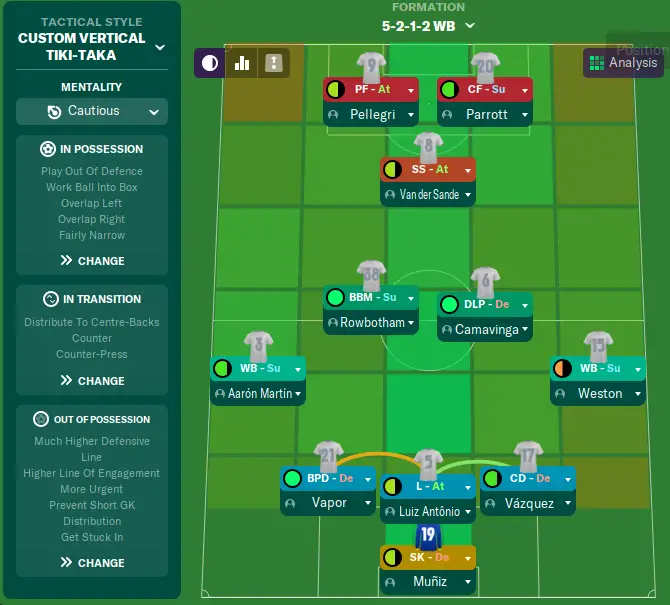
The three forward players will put pressure on the opposition’s defence and midfield, led by the pressing forward, quickly win the ball back before breaking on the counterattack.
The team’s main goal threat is the shadow striker, as the complete forward on support duty largely aims at bringing others into play rather than focusing on his goal-scoring duties.
Both the pressing forward and the complete forward will routinely chip in with goals, especially from crosses and cutbacks from the wing backs in the wide positions, but the tactic is set up with the shadow striker expected to shoulder the majority of the team’s attacking burden.
In central midfield, the box-to-box midfielder will make runs into the final third when the chances arise, but since the team’s mentality is in cautious, expect this to happen rarely. He will more often than not sit alongside the deep lying playmaker, who will be dictating play from deep.
The three-man central defence has a libero sitting between a ball-playing center-back and a central defender. The libero will add some creativity to the team, but the role is not crucial in whether the tactic is successful or not.
A normal ball-playing defender with either a stopper or cover duty depending on your defensive line can still work well in place of the libero.
